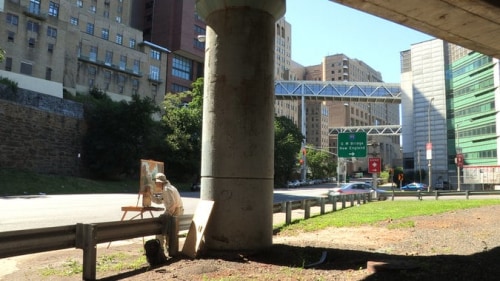
Rackstraw Downes at work in Manhattan. Credit Rima Yamazaki
For four decades, Mr. Downes, a master of the art of engaging with passing kibitzers, has worked at his version of a city of handsomely arched horizons, eye-catching textures and super-precise detail. He imagines himself as a curious pedestrian as he travels inconspicuously by subway to work with his easel, oils and brushes.
“It’s out of its mind, gone crazy, building higher and higher,” he anxiously notes of how the city has been changing before his eyes. “It gets tighter and tighter.” This tension is reflected in his paintings of swooping highway underpasses dappled with urban detritus, and other images that inspire curiosity about how the city will ever manage its future.
His devotion to painting the tiniest points of reflected light on each car and building window makes people think he paints from photographs, but he doesn’t. Rather, he savors each detail as a kind of signal of individual city dwellers. “Can individualization survive urban density?” is his repeated, pessimistic question about the city.
Other artists pay attention to him for his extensive writings on art history as much as for his painting. The MacArthur Foundation made him a fellow six years ago, citing his polymorphic talents and intertwining of nature and man-made objects as “a unique approach to realism.” Mr. Downes, who began as an abstract painter and found his own way, smiles at that. “Define realism and I’m willing to discuss it.”
In a few weeks, he heads back to his winter retreat in Texas, where he paints the most rural of landscapes in open country that has little in common with New York except the artist’s patient eye and brush stroke. He regrets there are fewer and fewer “nice, weedy spots to go to in New York to be at peace in the world; every inch is getting used and manicured.”
Still, Rackstraw Downes will be back for more of the city. He appreciates it for supplying his major work this summer — the interior of an office building’s utility room he happened upon downtown. It was stacked three levels high with booming air-conditioners, a sight as fantastic to him as Bruegel’s Tower of Babel. “My God, what a wonderful challenge,” says the artist, grateful for what New York keeps presenting to his eye.